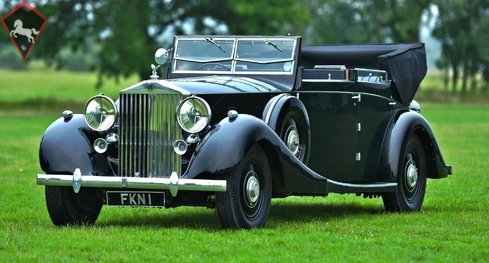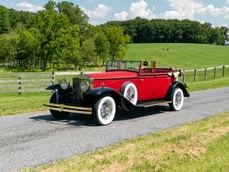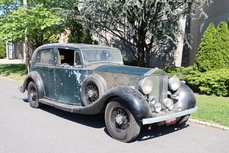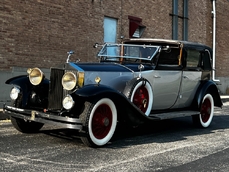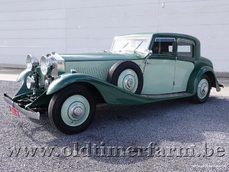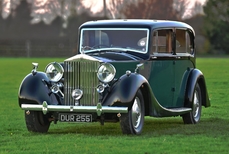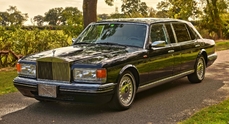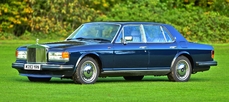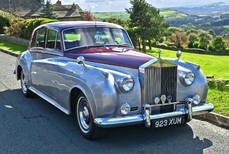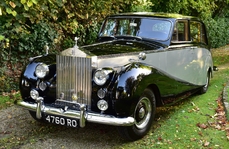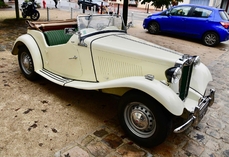Rolls-Royce Phantom II I Four Light Cabriolet Coachwork by Freestone & Webb 1938
General description :
Vintage and Prestige are proud to offer this 1938 Rolls-Royce Phantom III Four Light Cabriolet Coachwork by Freestone & Webb For Sale.
Chassis no: 3 DL 94
Engine no: Q88N
Design no: 1971
Body no: 1317
Registration: FKN 1
Mileage shown: 35,0147,338cc OHV aluminium V12 engine165bhp at 3,000rpm4-speed manual gearboxIndependent front suspension with coil springs, semi-elliptic springs rear 4-wheel-brakes servo assistedUnique coachworkOnly centre gearshift Phantom III built Perhaps the most outstanding luxury car of the 1930s - certainly to have been built in the United Kingdom - was the Rolls-Royce Phantom III. Introduced in 1936, the 7,340cc V12-engined Phantom III succeeded the Phantom II, the six-cylinder engine of which was considered to be at the end of its development life. The choice of a V12 configuration was a logical one for Rolls-Royce, the company already having had considerable experience of manufacturing V12 aero engines such as that used in the record-breaking Supermarine S6B seaplane. No doubt another consideration was the need to match the multi-cylinder opposition, notably the V16 Cadillac and V12 Hispano-Suiza. A state-of-the-art design employing advanced materials and techniques such as 'skeleton' cylinder blocks with wet liners and aluminum alloy cylinder heads, the PIII V12 produced 165bhp in its debut form. The maximum output was subsequently raised to 180 brake horsepower, which was sufficient to propel later examples to 100mph, earlier models being capable of around 90. Its engine configuration aside, the Phantom III represents an important milestone in the history of Rolls-Royce cars, being the first with independent front suspension. A total of 727 had been manufactured when WW2 halted production, of which around 300 exist worldwide today. By the late 1930s, coachbuilding design had evolved considerably from the 'Roaring Twenties' days, and there were far fewer open sporting bodies built at all on Rolls-Royce automobiles. Gone were the days of lavish spartan 'Torpedos' that were built on the first two series of Phantom chassis. The fashion was slightly more austere and inclined toward two door 'Drophead Coupes' which offered fully open or fully enclosed road conditions, and were more orientated to the owner-driver market. At the top end, luxury cars were still fully coachbuilt operations though, and the buyer of a Rolls-Royce was certainly in a position to decide precisely how their car would look and for what purpose it would be built, and a few of those clientele commissioned full 'all weather' bodies on the V12 Phantom III chassis. The numbers built were certainly modest at the time, and survivors such as this are even fewer. Among its higher brow and rare brethren, this is by any standards a rare automobile. It was ordered new by K.L. Bilbrough of Chislehurst in Kent, in the U.K., a wealthy gentleman who was by then the Chairman of the shipping and marine insurance business his father had founded in 1862. The story goes that its unique creation reflected Mr. Bilbrough's previous penchant for driving Packard motorcars, but when he elected to change for the latest model, he discovered to his dismay that the new car would not fit in his garage!
At this point, two domestic companies took over the mantel, Rolls-Royce and Freestone and Webb. Stipulating that the car must not exceed 17 feet, 7 inches, even with its bumpers fitted, the coachwork was designed. Other intriguing specifics were required, in order to match the central gear-change lever that he was used to in his Packard, the Rolls-Royce was built in this way also, it being the sole example of this model so equipped. White faced instruments were required with black numerals and bezels, and they were to be on a dash panel rather than in the standard cluster. No clock was fitted, nor a Spirit of Ecstasy hood ornament either. Further, he required that it be registered for the road with a license plate that he wouldn't forget, that number was 'FKN1', and when it was delivered to him it must have its odometer zeroed.
There were a number of slightly dated aspects to the order, such as the fitment of a bulb horn when electric horns were of course then the norm, and a four piece windshield which harked back to 1920s coachwork styles more than current traits. Freestone and Webb's design drawings and photos taken in period by Chas. Bowers confirm that the car was very much completed as specified. In fact it must have made quite an impression as Autocar featured the finished Phantom in their magazine in July 1939. It can also be safely assumed that Mr. Bilbrough was happy with his purchase as he would retain it for more than 23 years, in fact until his death in 1962, at the considerable age of 90. At this point the Rolls was sold by his estate, having covered a little under 34,000 miles in its lifetime. The next owner again kept the car until his passing in 2007, a lengthy 45 years of custodianship, at this point the ownership passed to his son. The son retained ownership for another 7 years, a cumulative ownership of 52 years within the same family.
This unique Phantom III must have had one of the simplest lives of any of these cars and for the most part remains highly original in detail and true to the form in which it was delivered new, save for a repaint to its fenders and re-upholstery of its seating areas, but never receiving a full restoration. Its mileage remains extremely low, particularly for these motors, at only 35,014 miles. In more recent times it has been sympathetically maintained by marque experts. She is running smoothly and driving beautifully.
In our showroom ready for viewing.
1938 Rolls-Royce Phantom II I Four Light Cabriolet Coachwork by Freestone & Webb is listed for sale on ClassicDigest in Essex by Prestige House for Not priced.
Car Facts
Car type : Car Make : Rolls-Royce Model : Phantom II Model Version : I Four Light Cabriolet Coachwork by Freestone & Webb Engine size : 0.0 Model Year : 1938 Sub type : Convertible Location : Essex Vehicle Registration : Undefined
Not priced
Seller Information
Vintage & Prestige
Prestige House
+44(0)1375 379719, +44(0)7967 260673
Prestige House
+44(0)1375 379719, +44(0)7967 260673
People who viewed this Rolls-Royce Phantom II also viewed similar Rolls-Royce listed at ClassicDigest
Other cars listed for sale by this dealer
About Rolls-Royce
Well, ladies and gentlemen, today we're diving into the illustrious history of a brand that has always embodied the very essence of British luxury and craftsmanship - Rolls-Royce.Our story begins at the turn of the 20th century when two visionaries, Charles Rolls and Henry Royce, decided to join forces. In 1904, the very first Rolls-Royce was born, the Rolls-Royce 10 hp. It was a modest start for a company that would go on to redefine automotive excellence.
But it wasn't until 1907 that Rolls-Royce truly made its mark with the introduction of the Silver Ghost. It was hailed as the "Best Car in the World" and set the gold standard for luxury motoring. With its whisper-quiet engine and exquisite craftsmanship, it was a statement of opulence and refinement.
The 1920s brought us the Rolls-Royce Phantom I, an icon of its time. It was the first Rolls-Royce to feature a 6-cylinder engine and set the stage for the legendary Phantom line. This was the era when the Maharajas of India commissioned custom-bodied Rolls-Royces that were nothing short of automotive palaces.
Fast forward to the post-war years, and we have the Silver Cloud, a symbol of post-war British optimism. The Silver Cloud was elegance personified, with its flowing lines and handcrafted interiors. It was the choice of royalty, celebrities, and captains of industry.
But if we're talking about the epitome of Rolls-Royce luxury, it's the Rolls-Royce Phantom VI, which graced us with its presence from 1968 to 1991. This was a car that made the statement that "if you have to ask the price, you can't afford it." Customization was the name of the game, and the Phantom VI was a canvas for the world's wealthiest to express their unique tastes.
Now, it's impossible to discuss Rolls-Royce without mentioning the Rolls-Royce Corniche. Produced from 1971 to 1995, it was a convertible and coupe version of the Silver Shadow. The Corniche was the quintessential grand tourer, a car for those who wished to traverse continents in absolute luxury.
But, alas, even the mightiest must face their decline, and Rolls-Royce was no exception. The company went through financial turmoil in the 1970s and 80s, leading to the takeover by Vickers plc. Then came the controversial BMW and Volkswagen ownership period, which divided enthusiasts.
Rolls-Royce regained its footing under BMW ownership, and the new millennium brought us the Rolls-Royce Phantom VII, a return to the company's roots of uncompromising luxury. The Phantom VII was a testament to British engineering and craftsmanship.
And that, ladies and gentlemen, brings us to today. Rolls-Royce continues to produce some of the most opulent, bespoke vehicles on the planet, a symbol of British imperiousness that has not waned with time. The spirit of Sir Henry Royce and Charles Rolls lives on in every car that bears the Spirit of Ecstasy, a testament to the enduring legacy of British automotive excellence.
